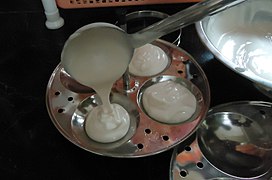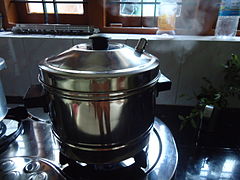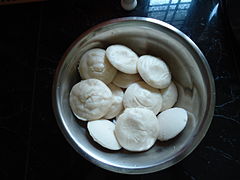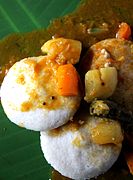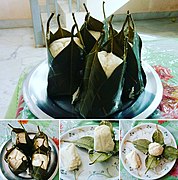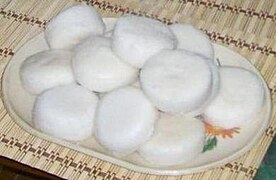Idli
Black lentils (de-husked), rice | |
| Variations | Button idli, tatte idli, sanna, sambar idli, rava idli, masala idli, shell idli |
|---|---|
Idli or idly (
Idli has several variations, including rava idli, which is made from semolina. Regional variants include sanna of Konkan.
History
A precursor of the modern idli is mentioned in several ancient Indian works.
The recipe mentioned in these ancient Indian works leaves out three key aspects of the modern idli recipe: the use of rice (not just black gram), the long fermentation of the mix, and the
The Gujarati work Varṇaka Samuccaya (1520 CE) mentions idli as idari, and also mentions its local adaptation, idada (a non-fermented version of dhokla).[8]
The earliest extant Tamil work to mention idli (as itali) is Maccapuranam, dated to the 17th century.[9][10] In 2015, Chennai-based Idli caterer Eniyavan started celebrating March 30 as "World Idli Day".[11]
Preparation
| Nutritional value per 1 piece (30 gm) | |
|---|---|
| Energy | 167 kJ (40 kcal) |
7.89 g | |
| Dietary fiber | 1.5 g |
0.19 g | |
| Saturated | 0.037 g |
| Monounsaturated | 0.035 g |
| Polyunsaturated | 0.043 g |
1.91 g | |
| Minerals | Quantity %DV† |
| Potassium | 2% 63 mg |
| Sodium | 9% 207 mg |
| †Percentages estimated using US recommendations for adults,[13] except for potassium, which is estimated based on expert recommendation from the National Academies.[14] Source: [12] | |
To make Idli, four parts uncooked rice (idli rice or parboiled rice) to one part whole white lentil (black gram, Vigna mungo) are soaked separately for at least four hours to six hours or overnight. Optionally spices such as fenugreek seeds can be added at the time of soaking for additional flavour. Once done soaking, the lentils are ground to a fine paste and the rice is separately coarsely ground, then they are combined. Next, the mixture is left to ferment overnight during which its volume will more than double. After fermentation, some of the batter may be kept as a starter culture for the next batch. The finished idli batter is put into greased moulds of an idli tray or "tree" for steaming. The perforated molds allow the idlis to be cooked evenly. The tree holds the trays above the level of boiling water in a pot, and the pot is covered until the idlis are done (about 10–25 minutes, depending on size). A more traditional method is to use leaves instead of moulds.[15]
- Making idlis
-
Key ingredients used are rice and black gram.
-
Idli batter
-
Idli mold
-
Batter poured into the mold
-
Several molds stacked over another
-
Idli steaming in cooker
-
Cooked idli
-
Molds removed from cooker
-
Idlis ready to eat
Serving
Since plain idlis are mild in taste, a condiment is considered essential. Idlis are often served with

Variations
There are several regional variations of idlis made in South India and Sri Lanka. With the emigration of south Indians and Sri Lankans throughout the region and world, many variations on idli have been created in addition to the almost countless local variations. Hard-to-get ingredients and differing cooking customs have required changes in both ingredients and methods.
In addition to or instead of fenugreek, other spices may be used such as mustard seeds, chili peppers, cumin, coriander, ginger, etc. A microwave or an automatic electric steamer that is non-stick is considered to be a convenient alternative to conventional stovetop steamers. Batter preparation using a manual rocking rock grinder can be replaced by electric grinders or blenders. Many restaurants have also come up with fusion recipes of idlis such as idly manchurian, idly fry, chilly idly, stuffed idly, to name a few.
-
Idlis cooked traditionally in coconut shells, Karnataka
-
Idli served with rasam
-
Moode idli steamed in fragrant screwpine leaves, Mangalore, Karnataka.
-
Sambar idli as served in Tamil Nadu
-
Kotte kadubu idlis steamed in jackfruit leaves, Karnataka
-
Rave idli (sooji idli) is a specialty of Karnataka
Batter fermentation mechanism
Fermentation of idli batter results in both leavening caused by the generation of carbon dioxide as well as an increase in acidity. This fermentation is performed by lactic acid bacteria, especially the heterofermentative strain Leuconostoc mesenteroides and the homofermentative strain Enterococcus faecalis (formerly classified as Streptococcus faecalis). Heterofermentative lactic acid bacteria such as L. mesenteroides generate both lactic acid as well as carbon dioxide whereas homofermentative lactic acid bacteria only generate lactic acid.
Both L. mesenteroides and E. faecalis are predominantly delivered to the batter by the black gram. Both strains start multiplying while the grains are soaking and continue to do so after grinding.
L. mesenteroides tolerates high concentrations of salt unlike most other bacteria. Hence the salt in the batter and the ongoing generation of lactic acid both suppress the growth of other undesirable micro-organisms.[22][23]
Idli Day
March 30 is celebrated as World Idli Day.[24] It was first celebrated in 2015 at Chennai.[25]
See also
- Bhapa pitha
- Cuisine of Karnataka
- Dhokla
- List of Indian breads
- List of steamed foods
- Puttu
- Rava idli
- Sanna
References
- ^ Edward R. Farnworth 2003, p. 11.
- ^ K. T. Achaya 1994, p. 90.
- ^ ISBN 978-81-7371-293-7.
- ^ D. Balasubramanian (21 October 2004). "Changes in the Indian menu over the ages". The Hindu. Archived from the original on 6 December 2014.
- ^ "Idli saga: A study into the origin of the South Indian dish".
- ^ Lenin, Janaki (30 March 2012). "A tale of two sambhars". The Hindu – via www.thehindu.com.
- ^ Feasts and Fasts: A History of Food in India, page 146, Colleen Taylor Sen (2015)
- ISBN 978-81-8475-185-7.
- ^ Vikram Doctor (28 April 2007). "Idli saga: A study into the origin of the South Indian dish". Economic Times. Retrieved 25 August 2014.
- ISBN 978-0-19-569844-2.
- ^ "World Idli Day 2018: Here's The Intriguing Story Behind This Delicious Day". NDTV. 30 March 2018.
- ^ "Calories in Idli and Nutrition Facts". www.fatsecret.co.in.
- ^ United States Food and Drug Administration (2024). "Daily Value on the Nutrition and Supplement Facts Labels". Retrieved 28 March 2024.
- )
- ^ "Idlis in jackfruit leaves". Aayi's Recipes. 2006. Retrieved 14 October 2014.
- ^ "Idli using Cream of Rice". Edibly Asian. Retrieved 14 October 2014.
- ^ Geeta, Seth. "Rava Idli : (Cream of wheat or sooji idli)". North India Cooking. Retrieved 14 October 2014.
- ^ "instant idli mix". Tarla Dalal. Sanjay & Co. Retrieved 14 October 2014.
- ^ Rachana, Gorikapudi (2012). "Fenugreek Leaves Idli". SPICY CURRIES. Retrieved 14 October 2014.
- ^ "Stuffed Idli". Spicy Tasty. 2013. Retrieved 14 October 2014.
- ^ "Idli Upma Recipe-Recipe with Leftover idlis". Padhu's Kitchen. 2012. Retrieved 14 October 2014.
- ISSN 0022-1147.
- PMID 25121339.
- ^ Agrawal, Saumya. "World Idli Day". Times Now News. Retrieved 30 March 2022.
- ^ Saha, Somdatta. "World Idli Day 2021". NDTV Food. Retrieved 30 March 2022.
Bibliography
- ISBN 978-0-19-563448-8.
- Devi, Yamuna (1987). Lord Krishna's Cuisine: The Art of Indian Vegetarian Cooking, Dutton. ISBN 0-525-24564-2.
- Edward R. Farnworth (2003). Handbook of Fermented Functional Foods. CRC Press. ISBN 978-0-8493-1372-1.
- Jaffrey, Madhur (1988). A Taste of India, Atheneum. ISBN 0-689-70726-6
- Rau, Santha Rama (1969). The Cooking of India, Time-Life Books.




